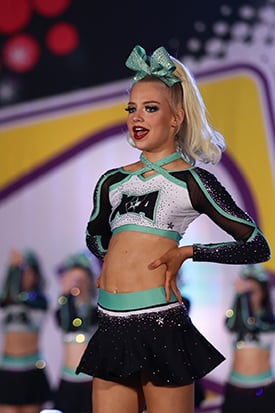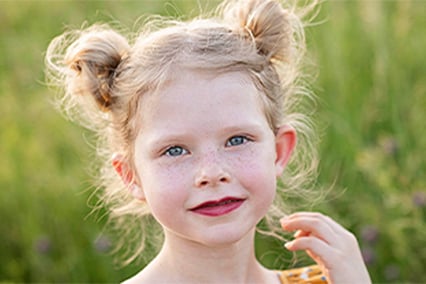Scoliosis and Spinal Fusion: Kiki's Story
Meet Kiki
By the time she started kindergarten, Kiki Moon was an accomplished athlete, tumbling, dancing and cheering in national cheerleading competitions.

“At 2, Kiki was doing cartwheels and forward rolls, plus a little cheer and a dance with jumps,” explained Debi Moon, her mom. “It was really cute and all about being with her friends and having fun.”
By 3, Kiki started to compete, and cheering became more than just a hobby—it quickly became, “her thing,” as Debi recalled. “She just loved it from the time she was a tiny little girl.”
Kiki worked hard to be competitive at the sport, and though cheer is physically demanding, she never suffered any injuries or had to take time away from practices or competitions.
But when Kiki turned 12 years old, her body began to change. As she was sitting next to her mom on the couch one day after school, Debi put her hand on Kiki’s back. She could feel one side of her daughter’s spine pushing out, the other pulling in.
Debi had never noticed the unusual curve before, and Kiki hadn’t complained about it either. “I thought, ‘When did this happen?’” Debi said.
“My sister-in-law, who is a respiratory therapist, suggested I take Kiki to the doctor to be checked for scoliosis, so I scheduled an appointment with her pediatrician,” Debi explained.
When the doctor asked Kiki to bend over and touch her toes, she immediately noticed the curve in her spine and referred her to Children’s Mercy Kansas City.
A new curve
At Children’s Mercy, Kiki’s orthopedic surgeon confirmed that she had developed adolescent idiopathic scoliosis, an abnormal curvature of the spine that appears in late childhood or adolescence.
Instead of growing straight, with scoliosis, the spine develops a side-to-side curvature characterized by an “S” shape. The bones of the spine also become slightly twisted or rotated.
Curves are more common in girls and progress most during the rapid growth period of adolescence, the age at which Kiki was diagnosed. In more severe cases, the curve in the spine can push on internal organs and can lead to serious complications.
Treatment often involves bracing or surgery. “I wasn’t ready for surgery,” Kiki said. “I didn’t want to take time away from cheering and school to recover.”
So instead, she opted for bracing, a treatment where the patient wears a specially-made brace for 20 hours a day to help straighten the spine or prevent the curve from getting worse.
“Kiki’s curve was already pretty severe when she was diagnosed, about 40 degrees,” Debi said. “But she wasn’t in any pain. Gymnasts and dancers often have very strong core muscles, which helps them with scoliosis.”
Kiki wore her brace as prescribed but was able to remove it for cheer practices and competitions. “She wasn’t excited about the brace, but she was growing so much at the time, we just hoped it would stop the curve from progressing.”
Time for surgery
Unfortunately, as Kiki grew, her scoliosis continued to advance, pushing past the 50-degree mark that often signals it’s time for surgery. After two long years with the brace as her constant companion, she was ready to give something else a try.
“Kiki was spending the night with a friend when I received a text from her that she was ready to schedule surgery,” Debi said.
“I was 15 at the time, and I knew that most people don’t cheer past high school and college,” Kiki said. “I wanted to go ahead and have the surgery so I could heal and continue to cheer competitively.”
Kiki’s Children’s Mercy orthopedic surgery team made sure she understood the surgery wouldn’t be easy, but that it should prevent the scoliosis from progressing into adulthood while correcting the deformity.
They scheduled a spinal fusion for May 2020. Kiki was mentally and physically ready for the operation and then the unthinkable happened—in March 2020 the COVID-19 pandemic hit.
“With the pandemic, everything was a question mark and we were told Kiki’s surgery was postponed indefinitely. We were so disappointed but just had to be patient!” Debi said.
A few weeks later, Children’s Mercy resumed surgeries. “It turned out that Kiki’s original surgery date was the first day they were going to be operating again. They asked if she still wanted the surgery,” Debi said.
Without hesitating, Kiki said “yes.” But that gave the family just two weeks to get her pre-surgical testing completed in the midst of the pandemic and to prepare for the big day.
After clearing every hurdle, Kiki’s surgery proceeded as planned. During an eight-hour operation, her doctor made a long incision straight down her back, then placed two titanium rods along with 24 screws and hooks in the vertebrae, straightening her spine and holding it in a better position.
Four days later, she returned to her Independence home to recover, participating in physical therapy at a nearby facility for the next three months.
Cheer all year!
Just two months after surgery, Kiki began working out again with her competitive and high school teams after receiving clearance from her doctor.
“I started with basic tumbling but had to re-learn how to do a lot of the things I had done most of my life,” Kiki said. “Some skills came back easily, and others were more challenging.”
Six months after surgery, she was doing back tucks and handsprings. “I was able to keep cheering as long as I wasn’t in any pain and I wasn’t,” Kiki said.

Now 17, Kiki is spending her senior year cheering for the Truman High School Patriots and competing year-round with the team she’s been a part of since she was a toddler, the Xtreme Cheer Allstars in Oak Grove, Mo.
When Kiki returned for her first competition in 2021 after recovering from surgery, the Xtreme Cheer Allstars won the open nationals, then closed the season out with a four-competition winning streak. She was also named a Universal Cheer Association (UCA) All-American and won all-state recognition for her position on the team as a backspot.
This season her high school team won the UCA regionals and secured a bid to compete at nationals in Florida.
“I love everything about cheer, competing and getting closer with my team. It’s a fun atmosphere,” Kiki said.
In fact, Kiki loves cheer so much, as she wraps up high school, she hopes to continue cheering in college and helping coach other kids interested in cheer.
Both Kiki and Debi credit her Children’s Mercy orthopedic team with helping her understand her scoliosis diagnosis and the options available to continue her cheer career.
“Everyone was easy to work with and very nice,” Kiki said. “I’m glad I decided to have the surgery. Everything is working well.”
An added bonus for the teen was minimal scarring. “Before the surgery, I hated the way my back looked in a swimsuit, but now it looks great,” Kiki said. “The scar is barely noticeable.”
Debi agreed and added, “It’s just incredible to see the difference this surgery has made for Kiki. Not only did it straighten her spine, but she gained three inches in height, going from 5’4” before surgery to 5’7” after.
“As a parent, it was hard to watch Kiki go through this, but I’m glad she went ahead and had the surgery while she is young and can recover easier,” Debi said.
“Her Children’s Mercy team has been fantastic. They have been so helpful and answered every question we had. Kiki won’t ever be able to do all the tumbling moves she did before, but she does so much it’s truly amazing!”
Early onset scoliosis: Quinn's story
Why is Quinn Liberman smiling? The 7-year-old is finished with serial Mehta casting and moving to the next phase of treatment at Children’s Mercy for her scoliosis—Rigo Cheneau bracing. To celebrate, she took time for a unique photo shoot documenting her journey.

- Spine Care
- Bracing Options for Scoliosis
- Growing Rods
- Halo Gravity Traction
- iSpine Clinic
- Mehta Casting
- Microdiscectomy for Disc Herniation
- Outreach Services
- Spinal Fusion
- Spine Care Consultations
- Spine Surgery: What to Expect
- Spondylolysis and Spondylolisthesis
- Vertebral Body Tethering
- Meet the Team
- Orthopedics
